Nissan Strategy Report: Environmental Analysis and Strategic Growth
VerifiedAdded on 2021/04/29
|20
|4975
|356
Report
AI Summary
This report provides a detailed strategic analysis of Nissan, encompassing a deep dive into its macro environment, including economic, political, social, and technological factors impacting the company. It further examines Nissan's internal environment and capabilities using frameworks such as VRIO/VRIN and McKinsey's 7S model, assessing its strengths, weaknesses, and competitive advantages. The report also evaluates the market sector using Porter's Five Forces model to understand competitive dynamics. Additionally, it explores Nissan's strategic directions, offering insights into its growth strategies and overall business development. The analysis includes a SWOT analysis, stakeholder analysis, and value chain analysis, providing a comprehensive understanding of Nissan's position in the automotive industry. This report serves as a valuable resource for students studying business strategy and environmental analysis, providing insights into a real-world case study.
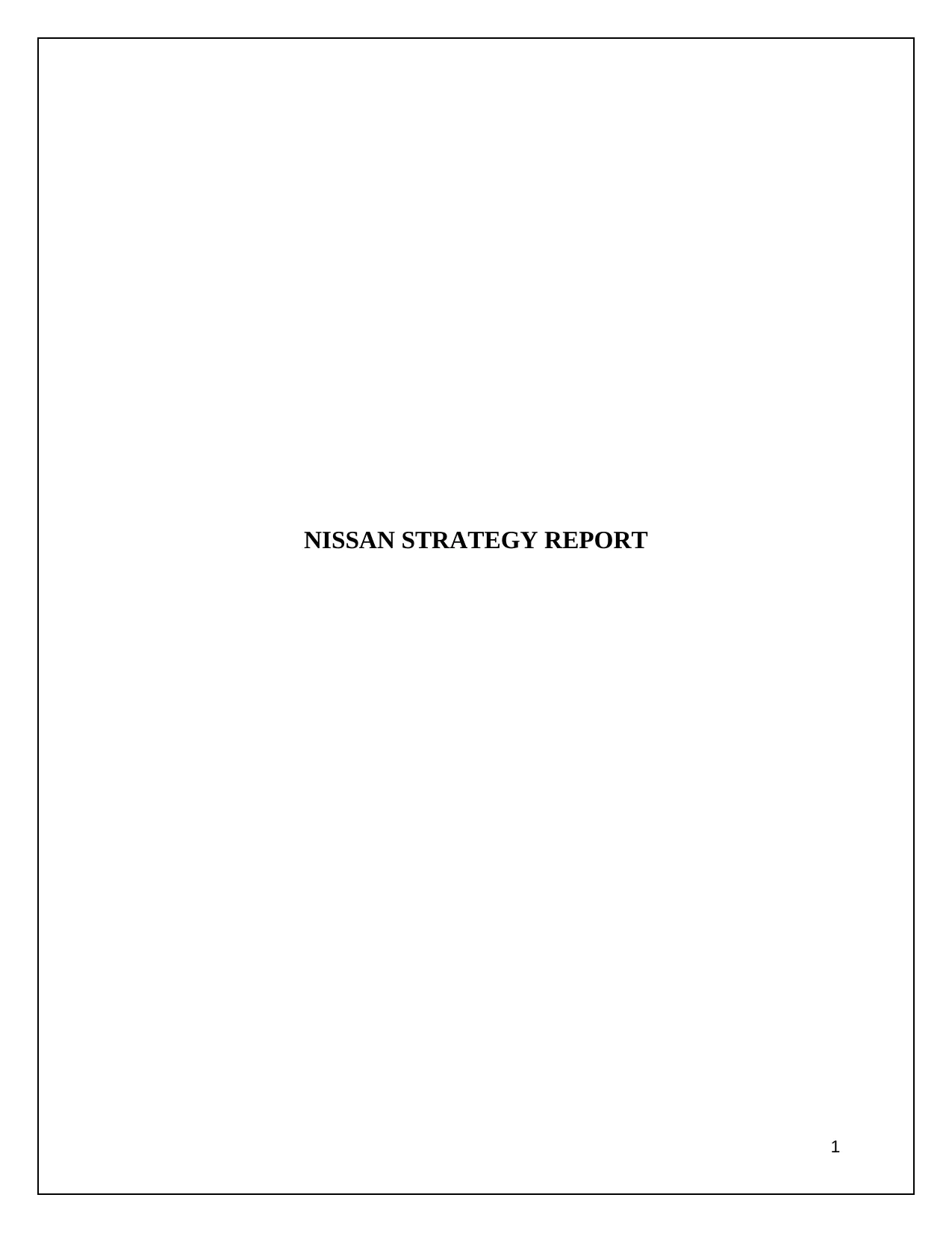
NISSAN STRATEGY REPORT
1
1
Paraphrase This Document
Need a fresh take? Get an instant paraphrase of this document with our AI Paraphraser
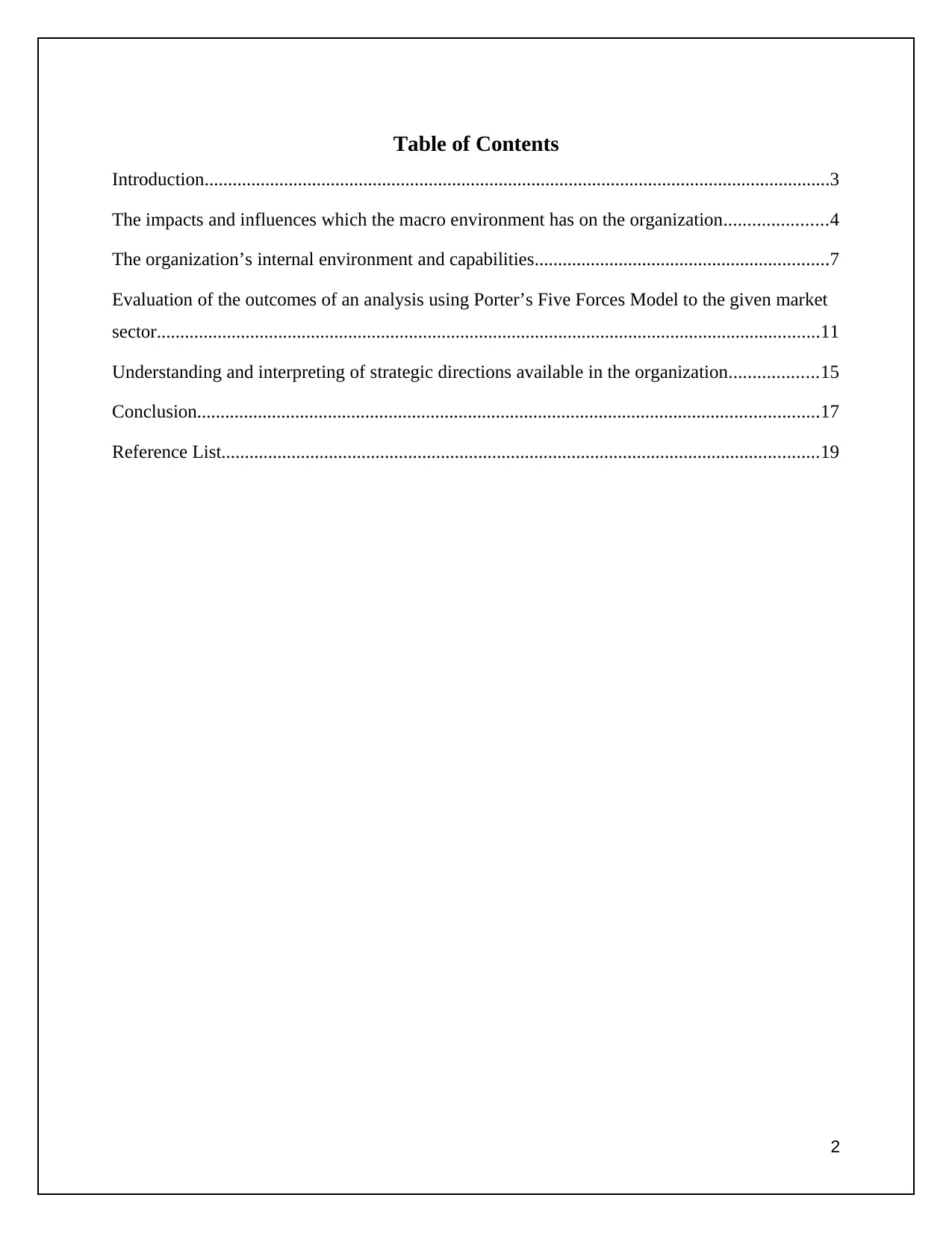
Table of Contents
Introduction......................................................................................................................................3
The impacts and influences which the macro environment has on the organization......................4
The organization’s internal environment and capabilities...............................................................7
Evaluation of the outcomes of an analysis using Porter’s Five Forces Model to the given market
sector..............................................................................................................................................11
Understanding and interpreting of strategic directions available in the organization...................15
Conclusion.....................................................................................................................................17
Reference List................................................................................................................................19
2
Introduction......................................................................................................................................3
The impacts and influences which the macro environment has on the organization......................4
The organization’s internal environment and capabilities...............................................................7
Evaluation of the outcomes of an analysis using Porter’s Five Forces Model to the given market
sector..............................................................................................................................................11
Understanding and interpreting of strategic directions available in the organization...................15
Conclusion.....................................................................................................................................17
Reference List................................................................................................................................19
2
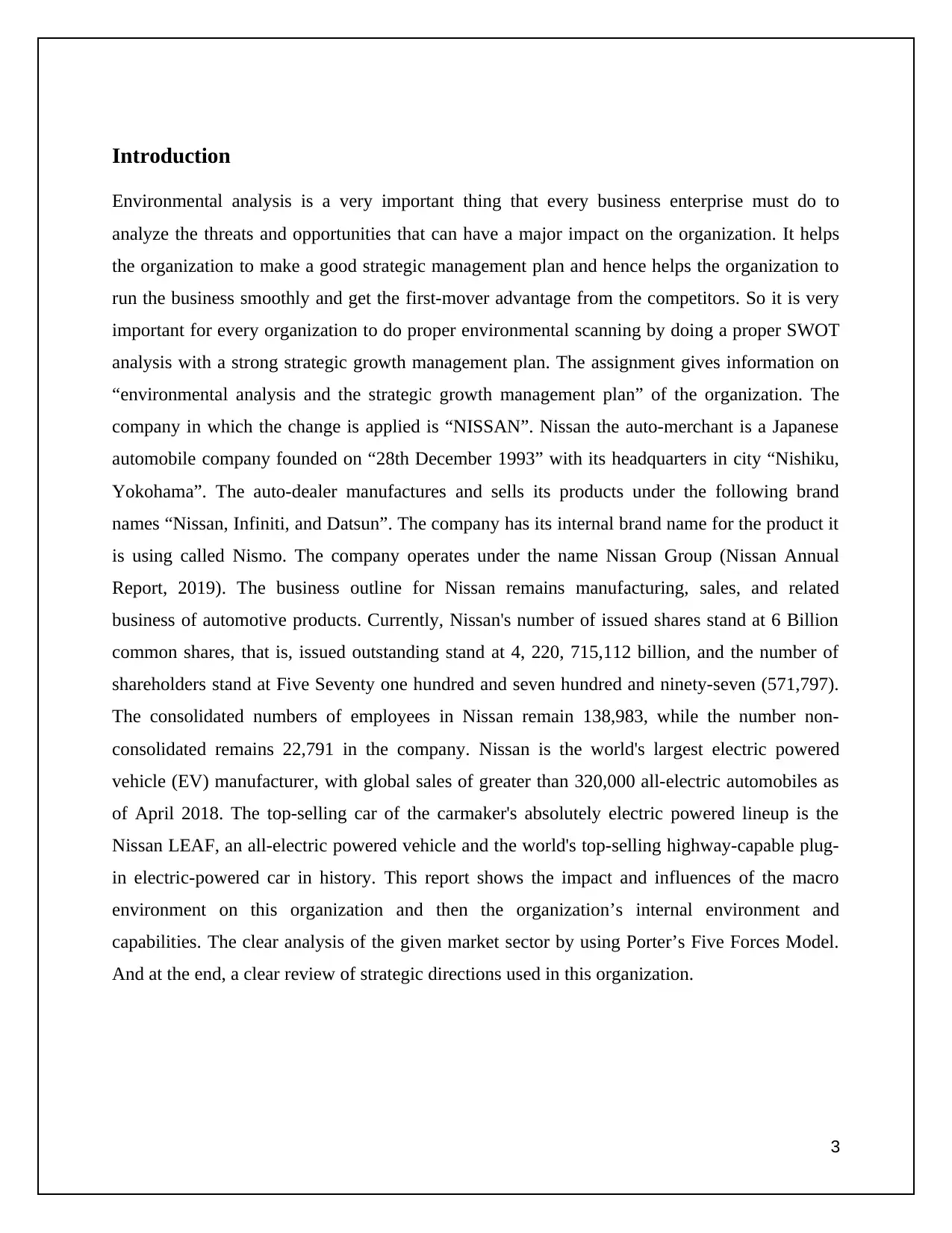
Introduction
Environmental analysis is a very important thing that every business enterprise must do to
analyze the threats and opportunities that can have a major impact on the organization. It helps
the organization to make a good strategic management plan and hence helps the organization to
run the business smoothly and get the first-mover advantage from the competitors. So it is very
important for every organization to do proper environmental scanning by doing a proper SWOT
analysis with a strong strategic growth management plan. The assignment gives information on
“environmental analysis and the strategic growth management plan” of the organization. The
company in which the change is applied is “NISSAN”. Nissan the auto-merchant is a Japanese
automobile company founded on “28th December 1993” with its headquarters in city “Nishiku,
Yokohama”. The auto-dealer manufactures and sells its products under the following brand
names “Nissan, Infiniti, and Datsun”. The company has its internal brand name for the product it
is using called Nismo. The company operates under the name Nissan Group (Nissan Annual
Report, 2019). The business outline for Nissan remains manufacturing, sales, and related
business of automotive products. Currently, Nissan's number of issued shares stand at 6 Billion
common shares, that is, issued outstanding stand at 4, 220, 715,112 billion, and the number of
shareholders stand at Five Seventy one hundred and seven hundred and ninety-seven (571,797).
The consolidated numbers of employees in Nissan remain 138,983, while the number non-
consolidated remains 22,791 in the company. Nissan is the world's largest electric powered
vehicle (EV) manufacturer, with global sales of greater than 320,000 all-electric automobiles as
of April 2018. The top-selling car of the carmaker's absolutely electric powered lineup is the
Nissan LEAF, an all-electric powered vehicle and the world's top-selling highway-capable plug-
in electric-powered car in history. This report shows the impact and influences of the macro
environment on this organization and then the organization’s internal environment and
capabilities. The clear analysis of the given market sector by using Porter’s Five Forces Model.
And at the end, a clear review of strategic directions used in this organization.
3
Environmental analysis is a very important thing that every business enterprise must do to
analyze the threats and opportunities that can have a major impact on the organization. It helps
the organization to make a good strategic management plan and hence helps the organization to
run the business smoothly and get the first-mover advantage from the competitors. So it is very
important for every organization to do proper environmental scanning by doing a proper SWOT
analysis with a strong strategic growth management plan. The assignment gives information on
“environmental analysis and the strategic growth management plan” of the organization. The
company in which the change is applied is “NISSAN”. Nissan the auto-merchant is a Japanese
automobile company founded on “28th December 1993” with its headquarters in city “Nishiku,
Yokohama”. The auto-dealer manufactures and sells its products under the following brand
names “Nissan, Infiniti, and Datsun”. The company has its internal brand name for the product it
is using called Nismo. The company operates under the name Nissan Group (Nissan Annual
Report, 2019). The business outline for Nissan remains manufacturing, sales, and related
business of automotive products. Currently, Nissan's number of issued shares stand at 6 Billion
common shares, that is, issued outstanding stand at 4, 220, 715,112 billion, and the number of
shareholders stand at Five Seventy one hundred and seven hundred and ninety-seven (571,797).
The consolidated numbers of employees in Nissan remain 138,983, while the number non-
consolidated remains 22,791 in the company. Nissan is the world's largest electric powered
vehicle (EV) manufacturer, with global sales of greater than 320,000 all-electric automobiles as
of April 2018. The top-selling car of the carmaker's absolutely electric powered lineup is the
Nissan LEAF, an all-electric powered vehicle and the world's top-selling highway-capable plug-
in electric-powered car in history. This report shows the impact and influences of the macro
environment on this organization and then the organization’s internal environment and
capabilities. The clear analysis of the given market sector by using Porter’s Five Forces Model.
And at the end, a clear review of strategic directions used in this organization.
3
⊘ This is a preview!⊘
Do you want full access?
Subscribe today to unlock all pages.

Trusted by 1+ million students worldwide
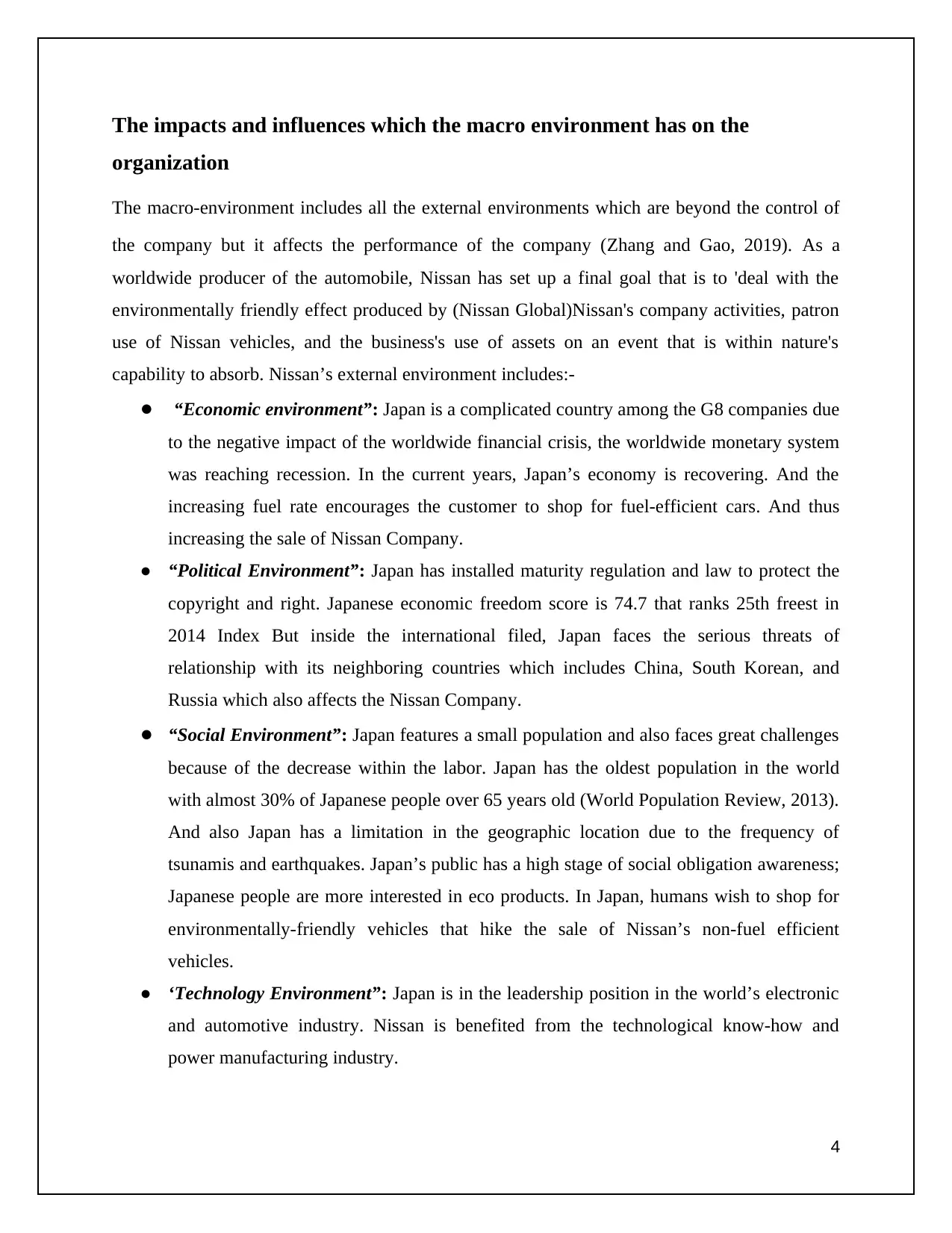
The impacts and influences which the macro environment has on the
organization
The macro-environment includes all the external environments which are beyond the control of
the company but it affects the performance of the company (Zhang and Gao, 2019). As a
worldwide producer of the automobile, Nissan has set up a final goal that is to 'deal with the
environmentally friendly effect produced by (Nissan Global)Nissan's company activities, patron
use of Nissan vehicles, and the business's use of assets on an event that is within nature's
capability to absorb. Nissan’s external environment includes:-
● “Economic environment”: Japan is a complicated country among the G8 companies due
to the negative impact of the worldwide financial crisis, the worldwide monetary system
was reaching recession. In the current years, Japan’s economy is recovering. And the
increasing fuel rate encourages the customer to shop for fuel-efficient cars. And thus
increasing the sale of Nissan Company.
● “Political Environment”: Japan has installed maturity regulation and law to protect the
copyright and right. Japanese economic freedom score is 74.7 that ranks 25th freest in
2014 Index But inside the international filed, Japan faces the serious threats of
relationship with its neighboring countries which includes China, South Korean, and
Russia which also affects the Nissan Company.
● “Social Environment”: Japan features a small population and also faces great challenges
because of the decrease within the labor. Japan has the oldest population in the world
with almost 30% of Japanese people over 65 years old (World Population Review, 2013).
And also Japan has a limitation in the geographic location due to the frequency of
tsunamis and earthquakes. Japan’s public has a high stage of social obligation awareness;
Japanese people are more interested in eco products. In Japan, humans wish to shop for
environmentally-friendly vehicles that hike the sale of Nissan’s non-fuel efficient
vehicles.
● ‘Technology Environment”: Japan is in the leadership position in the world’s electronic
and automotive industry. Nissan is benefited from the technological know-how and
power manufacturing industry.
4
organization
The macro-environment includes all the external environments which are beyond the control of
the company but it affects the performance of the company (Zhang and Gao, 2019). As a
worldwide producer of the automobile, Nissan has set up a final goal that is to 'deal with the
environmentally friendly effect produced by (Nissan Global)Nissan's company activities, patron
use of Nissan vehicles, and the business's use of assets on an event that is within nature's
capability to absorb. Nissan’s external environment includes:-
● “Economic environment”: Japan is a complicated country among the G8 companies due
to the negative impact of the worldwide financial crisis, the worldwide monetary system
was reaching recession. In the current years, Japan’s economy is recovering. And the
increasing fuel rate encourages the customer to shop for fuel-efficient cars. And thus
increasing the sale of Nissan Company.
● “Political Environment”: Japan has installed maturity regulation and law to protect the
copyright and right. Japanese economic freedom score is 74.7 that ranks 25th freest in
2014 Index But inside the international filed, Japan faces the serious threats of
relationship with its neighboring countries which includes China, South Korean, and
Russia which also affects the Nissan Company.
● “Social Environment”: Japan features a small population and also faces great challenges
because of the decrease within the labor. Japan has the oldest population in the world
with almost 30% of Japanese people over 65 years old (World Population Review, 2013).
And also Japan has a limitation in the geographic location due to the frequency of
tsunamis and earthquakes. Japan’s public has a high stage of social obligation awareness;
Japanese people are more interested in eco products. In Japan, humans wish to shop for
environmentally-friendly vehicles that hike the sale of Nissan’s non-fuel efficient
vehicles.
● ‘Technology Environment”: Japan is in the leadership position in the world’s electronic
and automotive industry. Nissan is benefited from the technological know-how and
power manufacturing industry.
4
Paraphrase This Document
Need a fresh take? Get an instant paraphrase of this document with our AI Paraphraser
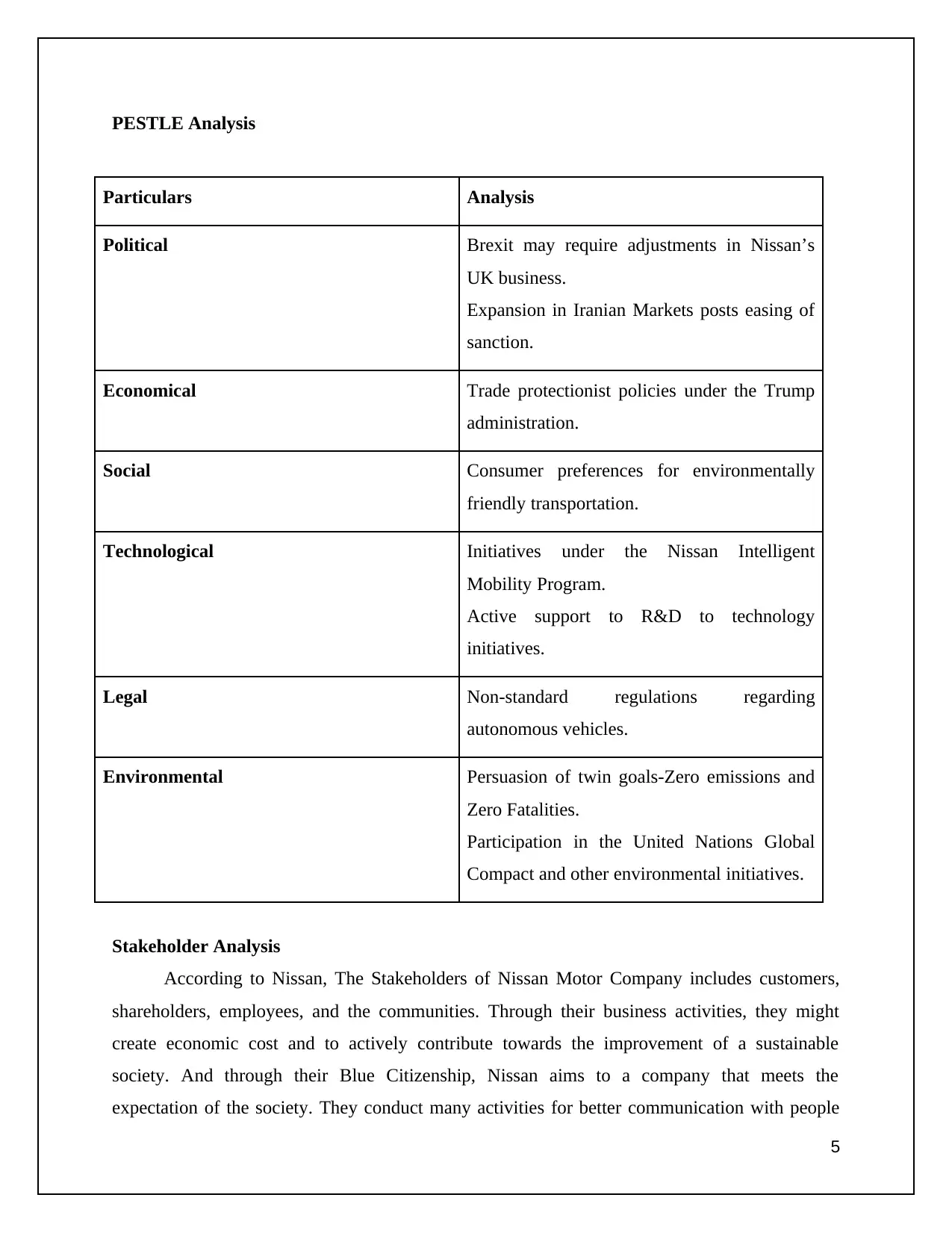
PESTLE Analysis
Particulars Analysis
Political Brexit may require adjustments in Nissan’s
UK business.
Expansion in Iranian Markets posts easing of
sanction.
Economical Trade protectionist policies under the Trump
administration.
Social Consumer preferences for environmentally
friendly transportation.
Technological Initiatives under the Nissan Intelligent
Mobility Program.
Active support to R&D to technology
initiatives.
Legal Non-standard regulations regarding
autonomous vehicles.
Environmental Persuasion of twin goals-Zero emissions and
Zero Fatalities.
Participation in the United Nations Global
Compact and other environmental initiatives.
Stakeholder Analysis
According to Nissan, The Stakeholders of Nissan Motor Company includes customers,
shareholders, employees, and the communities. Through their business activities, they might
create economic cost and to actively contribute towards the improvement of a sustainable
society. And through their Blue Citizenship, Nissan aims to a company that meets the
expectation of the society. They conduct many activities for better communication with people
5
Particulars Analysis
Political Brexit may require adjustments in Nissan’s
UK business.
Expansion in Iranian Markets posts easing of
sanction.
Economical Trade protectionist policies under the Trump
administration.
Social Consumer preferences for environmentally
friendly transportation.
Technological Initiatives under the Nissan Intelligent
Mobility Program.
Active support to R&D to technology
initiatives.
Legal Non-standard regulations regarding
autonomous vehicles.
Environmental Persuasion of twin goals-Zero emissions and
Zero Fatalities.
Participation in the United Nations Global
Compact and other environmental initiatives.
Stakeholder Analysis
According to Nissan, The Stakeholders of Nissan Motor Company includes customers,
shareholders, employees, and the communities. Through their business activities, they might
create economic cost and to actively contribute towards the improvement of a sustainable
society. And through their Blue Citizenship, Nissan aims to a company that meets the
expectation of the society. They conduct many activities for better communication with people
5
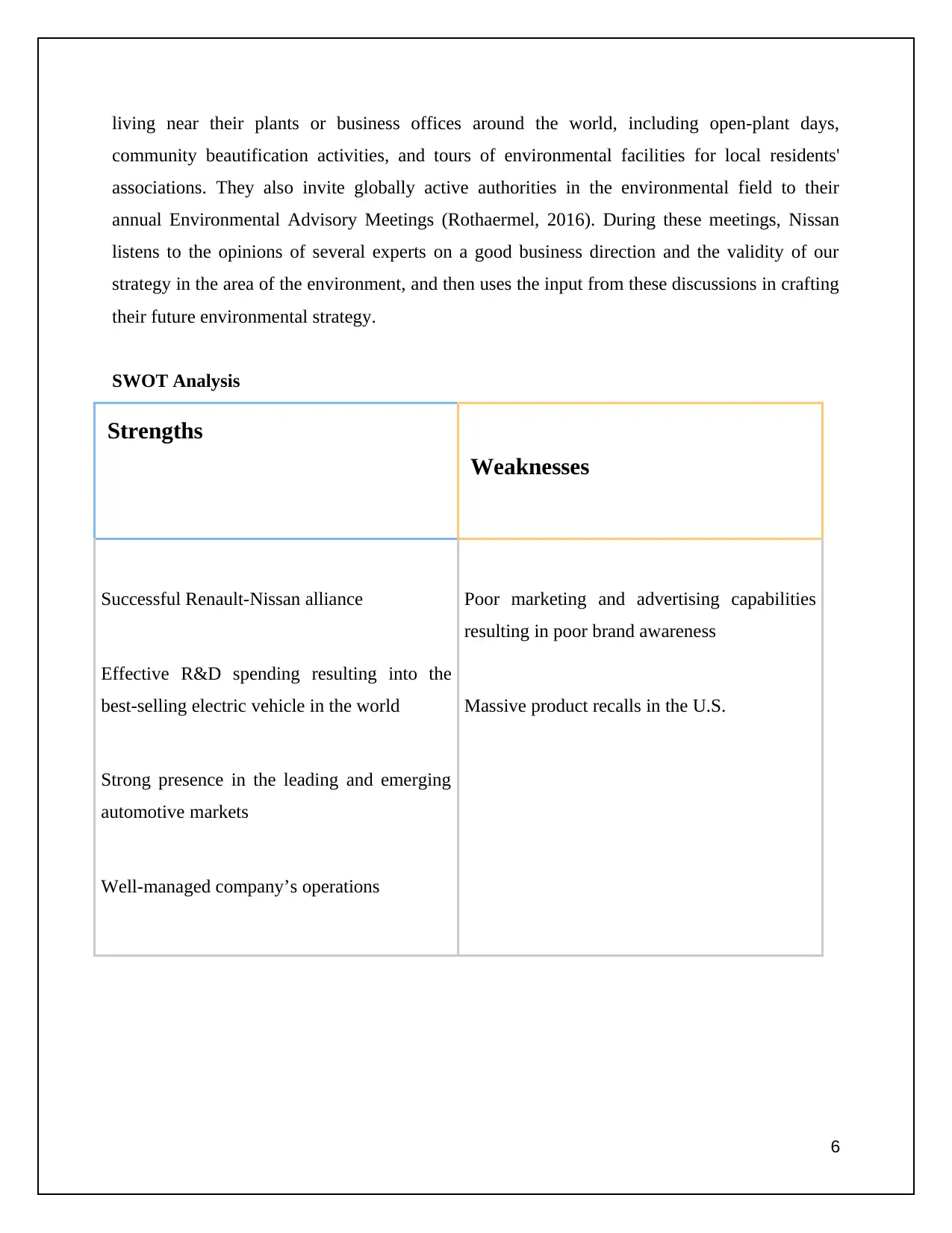
living near their plants or business offices around the world, including open-plant days,
community beautification activities, and tours of environmental facilities for local residents'
associations. They also invite globally active authorities in the environmental field to their
annual Environmental Advisory Meetings (Rothaermel, 2016). During these meetings, Nissan
listens to the opinions of several experts on a good business direction and the validity of our
strategy in the area of the environment, and then uses the input from these discussions in crafting
their future environmental strategy.
SWOT Analysis
Strengths
Weaknesses
Successful Renault-Nissan alliance
Effective R&D spending resulting into the
best-selling electric vehicle in the world
Strong presence in the leading and emerging
automotive markets
Well-managed company’s operations
Poor marketing and advertising capabilities
resulting in poor brand awareness
Massive product recalls in the U.S.
6
community beautification activities, and tours of environmental facilities for local residents'
associations. They also invite globally active authorities in the environmental field to their
annual Environmental Advisory Meetings (Rothaermel, 2016). During these meetings, Nissan
listens to the opinions of several experts on a good business direction and the validity of our
strategy in the area of the environment, and then uses the input from these discussions in crafting
their future environmental strategy.
SWOT Analysis
Strengths
Weaknesses
Successful Renault-Nissan alliance
Effective R&D spending resulting into the
best-selling electric vehicle in the world
Strong presence in the leading and emerging
automotive markets
Well-managed company’s operations
Poor marketing and advertising capabilities
resulting in poor brand awareness
Massive product recalls in the U.S.
6
⊘ This is a preview!⊘
Do you want full access?
Subscribe today to unlock all pages.

Trusted by 1+ million students worldwide
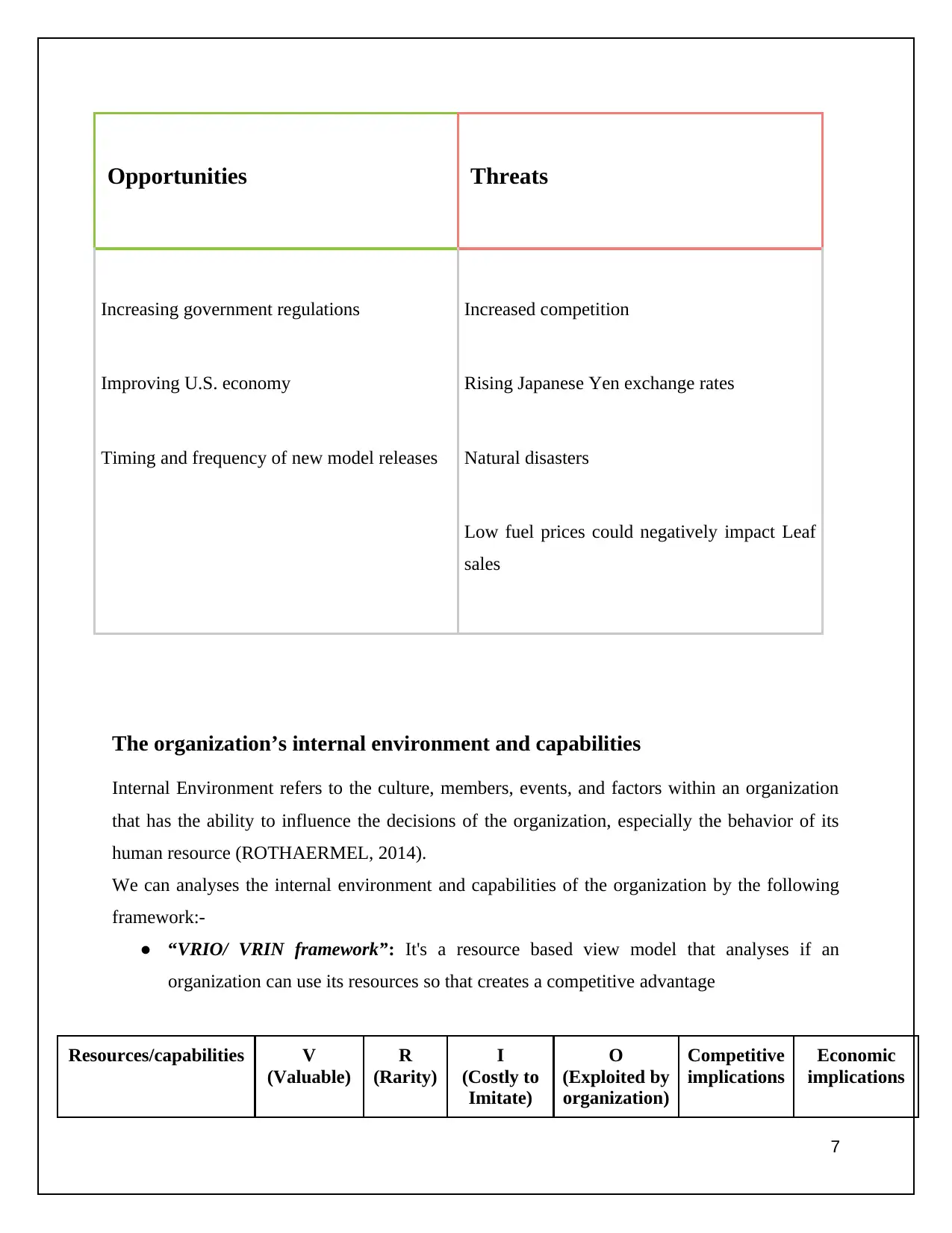
Opportunities Threats
Increasing government regulations
Improving U.S. economy
Timing and frequency of new model releases
Increased competition
Rising Japanese Yen exchange rates
Natural disasters
Low fuel prices could negatively impact Leaf
sales
The organization’s internal environment and capabilities
Internal Environment refers to the culture, members, events, and factors within an organization
that has the ability to influence the decisions of the organization, especially the behavior of its
human resource (ROTHAERMEL, 2014).
We can analyses the internal environment and capabilities of the organization by the following
framework:-
● “VRIO/ VRIN framework”: It's a resource based view model that analyses if an
organization can use its resources so that creates a competitive advantage
Resources/capabilities V
(Valuable)
R
(Rarity)
I
(Costly to
Imitate)
O
(Exploited by
organization)
Competitive
implications
Economic
implications
7
Increasing government regulations
Improving U.S. economy
Timing and frequency of new model releases
Increased competition
Rising Japanese Yen exchange rates
Natural disasters
Low fuel prices could negatively impact Leaf
sales
The organization’s internal environment and capabilities
Internal Environment refers to the culture, members, events, and factors within an organization
that has the ability to influence the decisions of the organization, especially the behavior of its
human resource (ROTHAERMEL, 2014).
We can analyses the internal environment and capabilities of the organization by the following
framework:-
● “VRIO/ VRIN framework”: It's a resource based view model that analyses if an
organization can use its resources so that creates a competitive advantage
Resources/capabilities V
(Valuable)
R
(Rarity)
I
(Costly to
Imitate)
O
(Exploited by
organization)
Competitive
implications
Economic
implications
7
Paraphrase This Document
Need a fresh take? Get an instant paraphrase of this document with our AI Paraphraser
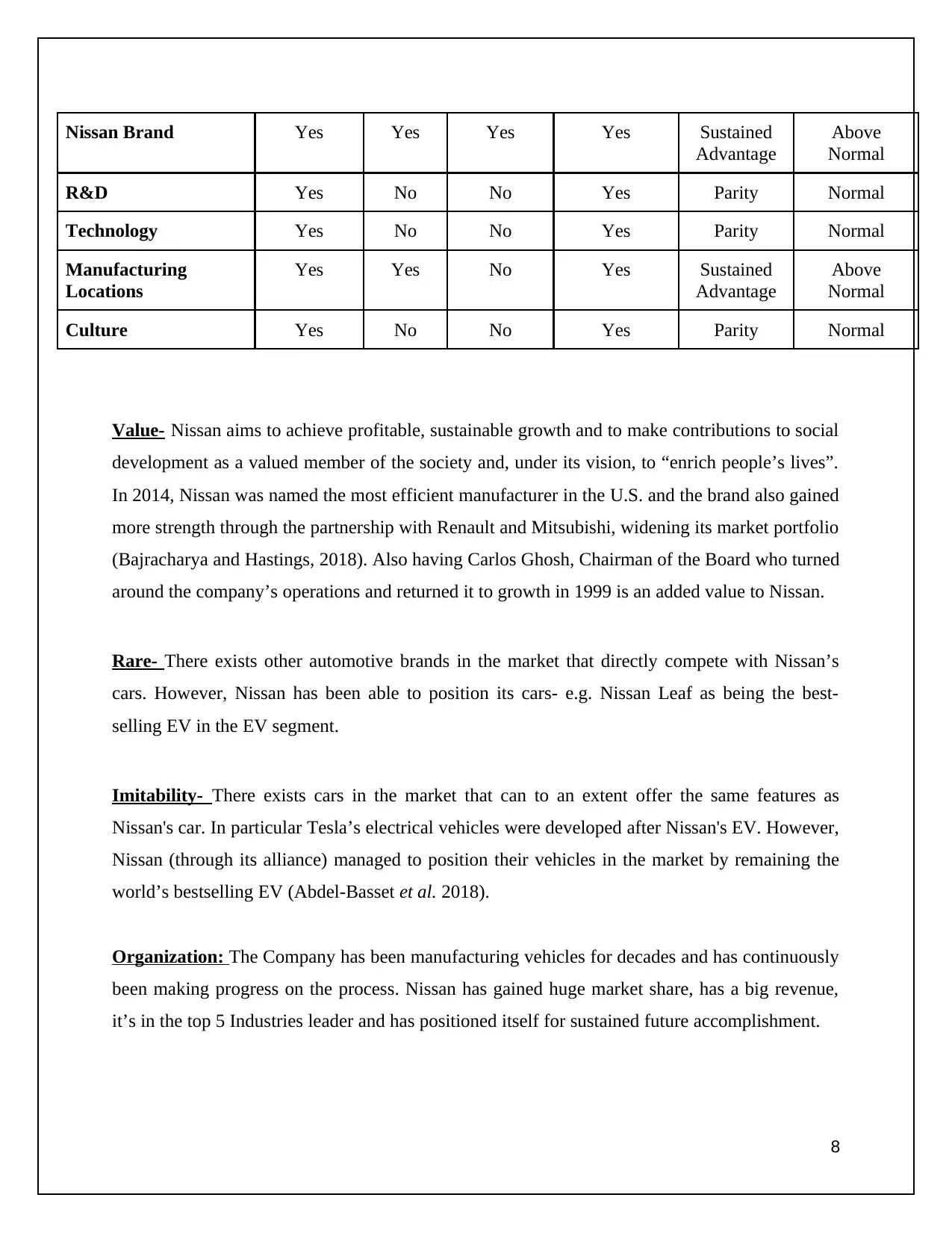
Nissan Brand Yes Yes Yes Yes Sustained
Advantage
Above
Normal
R&D Yes No No Yes Parity Normal
Technology Yes No No Yes Parity Normal
Manufacturing
Locations
Yes Yes No Yes Sustained
Advantage
Above
Normal
Culture Yes No No Yes Parity Normal
Value- Nissan aims to achieve profitable, sustainable growth and to make contributions to social
development as a valued member of the society and, under its vision, to “enrich people’s lives”.
In 2014, Nissan was named the most efficient manufacturer in the U.S. and the brand also gained
more strength through the partnership with Renault and Mitsubishi, widening its market portfolio
(Bajracharya and Hastings, 2018). Also having Carlos Ghosh, Chairman of the Board who turned
around the company’s operations and returned it to growth in 1999 is an added value to Nissan.
Rare- There exists other automotive brands in the market that directly compete with Nissan’s
cars. However, Nissan has been able to position its cars- e.g. Nissan Leaf as being the best-
selling EV in the EV segment.
Imitability- There exists cars in the market that can to an extent offer the same features as
Nissan's car. In particular Tesla’s electrical vehicles were developed after Nissan's EV. However,
Nissan (through its alliance) managed to position their vehicles in the market by remaining the
world’s bestselling EV (Abdel-Basset et al. 2018).
Organization: The Company has been manufacturing vehicles for decades and has continuously
been making progress on the process. Nissan has gained huge market share, has a big revenue,
it’s in the top 5 Industries leader and has positioned itself for sustained future accomplishment.
8
Advantage
Above
Normal
R&D Yes No No Yes Parity Normal
Technology Yes No No Yes Parity Normal
Manufacturing
Locations
Yes Yes No Yes Sustained
Advantage
Above
Normal
Culture Yes No No Yes Parity Normal
Value- Nissan aims to achieve profitable, sustainable growth and to make contributions to social
development as a valued member of the society and, under its vision, to “enrich people’s lives”.
In 2014, Nissan was named the most efficient manufacturer in the U.S. and the brand also gained
more strength through the partnership with Renault and Mitsubishi, widening its market portfolio
(Bajracharya and Hastings, 2018). Also having Carlos Ghosh, Chairman of the Board who turned
around the company’s operations and returned it to growth in 1999 is an added value to Nissan.
Rare- There exists other automotive brands in the market that directly compete with Nissan’s
cars. However, Nissan has been able to position its cars- e.g. Nissan Leaf as being the best-
selling EV in the EV segment.
Imitability- There exists cars in the market that can to an extent offer the same features as
Nissan's car. In particular Tesla’s electrical vehicles were developed after Nissan's EV. However,
Nissan (through its alliance) managed to position their vehicles in the market by remaining the
world’s bestselling EV (Abdel-Basset et al. 2018).
Organization: The Company has been manufacturing vehicles for decades and has continuously
been making progress on the process. Nissan has gained huge market share, has a big revenue,
it’s in the top 5 Industries leader and has positioned itself for sustained future accomplishment.
8
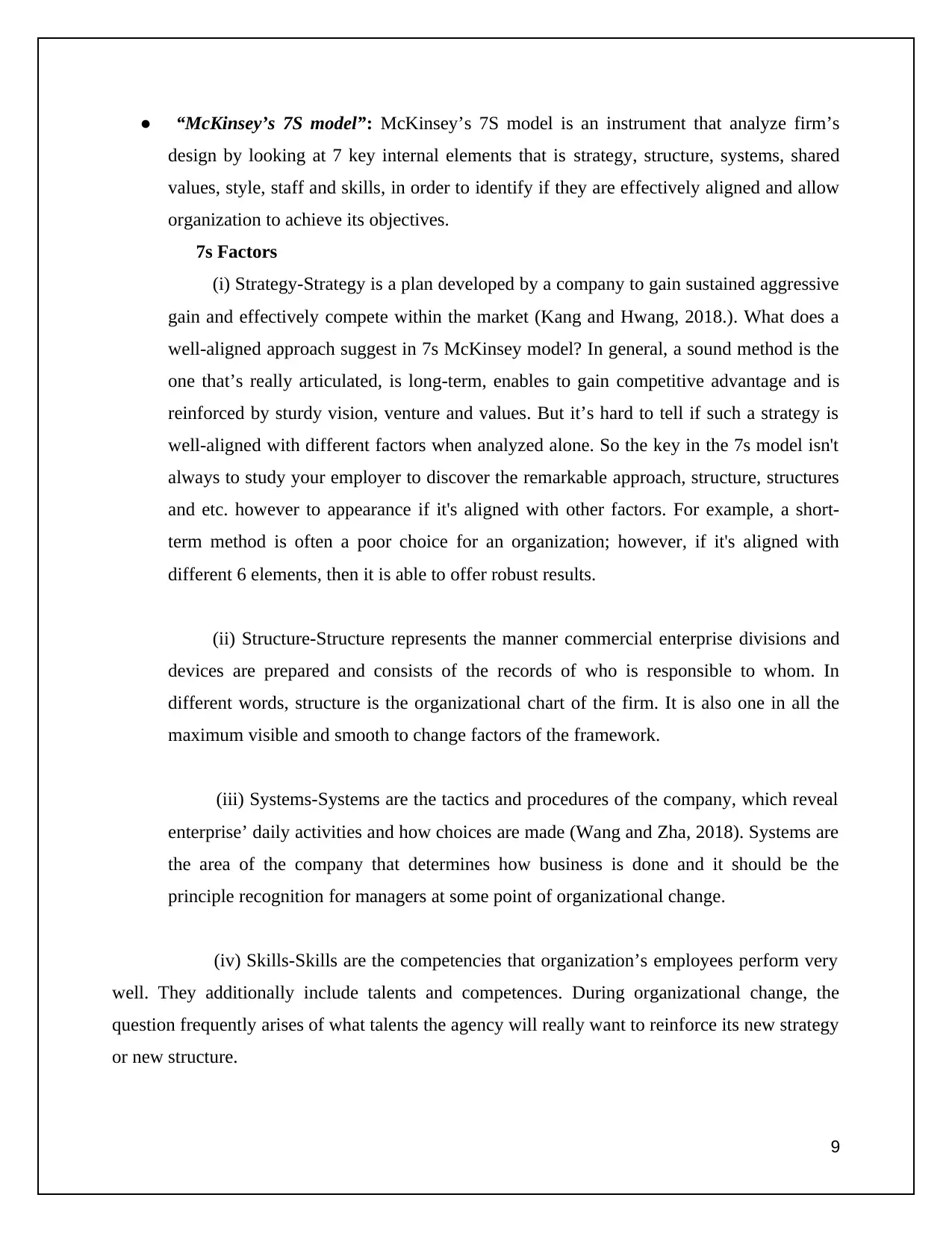
● “McKinsey’s 7S model”: McKinsey’s 7S model is an instrument that analyze firm’s
design by looking at 7 key internal elements that is strategy, structure, systems, shared
values, style, staff and skills, in order to identify if they are effectively aligned and allow
organization to achieve its objectives.
7s Factors
(i) Strategy-Strategy is a plan developed by a company to gain sustained aggressive
gain and effectively compete within the market (Kang and Hwang, 2018.). What does a
well-aligned approach suggest in 7s McKinsey model? In general, a sound method is the
one that’s really articulated, is long-term, enables to gain competitive advantage and is
reinforced by sturdy vision, venture and values. But it’s hard to tell if such a strategy is
well-aligned with different factors when analyzed alone. So the key in the 7s model isn't
always to study your employer to discover the remarkable approach, structure, structures
and etc. however to appearance if it's aligned with other factors. For example, a short-
term method is often a poor choice for an organization; however, if it's aligned with
different 6 elements, then it is able to offer robust results.
(ii) Structure-Structure represents the manner commercial enterprise divisions and
devices are prepared and consists of the records of who is responsible to whom. In
different words, structure is the organizational chart of the firm. It is also one in all the
maximum visible and smooth to change factors of the framework.
(iii) Systems-Systems are the tactics and procedures of the company, which reveal
enterprise’ daily activities and how choices are made (Wang and Zha, 2018). Systems are
the area of the company that determines how business is done and it should be the
principle recognition for managers at some point of organizational change.
(iv) Skills-Skills are the competencies that organization’s employees perform very
well. They additionally include talents and competences. During organizational change, the
question frequently arises of what talents the agency will really want to reinforce its new strategy
or new structure.
9
design by looking at 7 key internal elements that is strategy, structure, systems, shared
values, style, staff and skills, in order to identify if they are effectively aligned and allow
organization to achieve its objectives.
7s Factors
(i) Strategy-Strategy is a plan developed by a company to gain sustained aggressive
gain and effectively compete within the market (Kang and Hwang, 2018.). What does a
well-aligned approach suggest in 7s McKinsey model? In general, a sound method is the
one that’s really articulated, is long-term, enables to gain competitive advantage and is
reinforced by sturdy vision, venture and values. But it’s hard to tell if such a strategy is
well-aligned with different factors when analyzed alone. So the key in the 7s model isn't
always to study your employer to discover the remarkable approach, structure, structures
and etc. however to appearance if it's aligned with other factors. For example, a short-
term method is often a poor choice for an organization; however, if it's aligned with
different 6 elements, then it is able to offer robust results.
(ii) Structure-Structure represents the manner commercial enterprise divisions and
devices are prepared and consists of the records of who is responsible to whom. In
different words, structure is the organizational chart of the firm. It is also one in all the
maximum visible and smooth to change factors of the framework.
(iii) Systems-Systems are the tactics and procedures of the company, which reveal
enterprise’ daily activities and how choices are made (Wang and Zha, 2018). Systems are
the area of the company that determines how business is done and it should be the
principle recognition for managers at some point of organizational change.
(iv) Skills-Skills are the competencies that organization’s employees perform very
well. They additionally include talents and competences. During organizational change, the
question frequently arises of what talents the agency will really want to reinforce its new strategy
or new structure.
9
⊘ This is a preview!⊘
Do you want full access?
Subscribe today to unlock all pages.

Trusted by 1+ million students worldwide
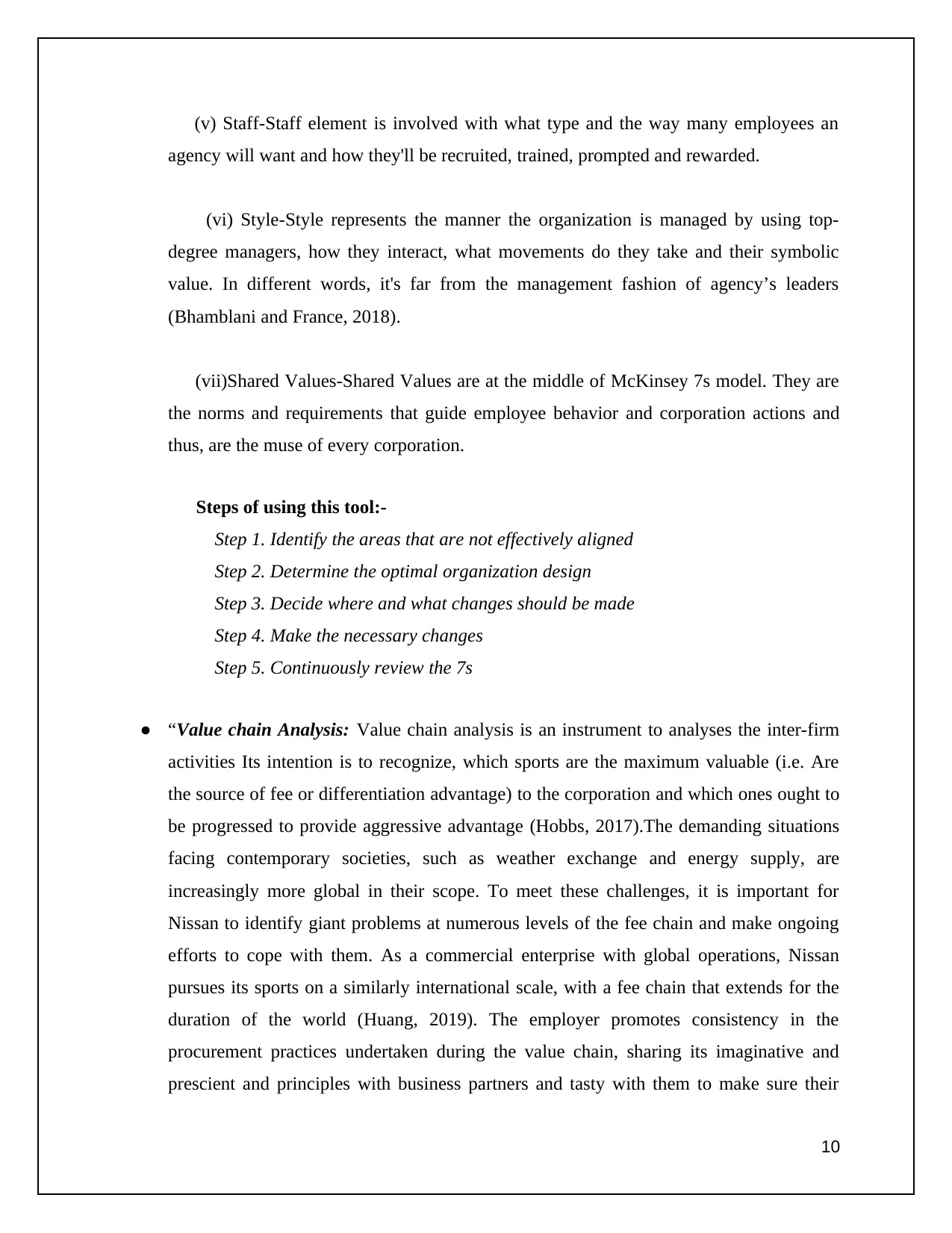
(v) Staff-Staff element is involved with what type and the way many employees an
agency will want and how they'll be recruited, trained, prompted and rewarded.
(vi) Style-Style represents the manner the organization is managed by using top-
degree managers, how they interact, what movements do they take and their symbolic
value. In different words, it's far from the management fashion of agency’s leaders
(Bhamblani and France, 2018).
(vii)Shared Values-Shared Values are at the middle of McKinsey 7s model. They are
the norms and requirements that guide employee behavior and corporation actions and
thus, are the muse of every corporation.
Steps of using this tool:-
Step 1. Identify the areas that are not effectively aligned
Step 2. Determine the optimal organization design
Step 3. Decide where and what changes should be made
Step 4. Make the necessary changes
Step 5. Continuously review the 7s
● “Value chain Analysis: Value chain analysis is an instrument to analyses the inter-firm
activities Its intention is to recognize, which sports are the maximum valuable (i.e. Are
the source of fee or differentiation advantage) to the corporation and which ones ought to
be progressed to provide aggressive advantage (Hobbs, 2017).The demanding situations
facing contemporary societies, such as weather exchange and energy supply, are
increasingly more global in their scope. To meet these challenges, it is important for
Nissan to identify giant problems at numerous levels of the fee chain and make ongoing
efforts to cope with them. As a commercial enterprise with global operations, Nissan
pursues its sports on a similarly international scale, with a fee chain that extends for the
duration of the world (Huang, 2019). The employer promotes consistency in the
procurement practices undertaken during the value chain, sharing its imaginative and
prescient and principles with business partners and tasty with them to make sure their
10
agency will want and how they'll be recruited, trained, prompted and rewarded.
(vi) Style-Style represents the manner the organization is managed by using top-
degree managers, how they interact, what movements do they take and their symbolic
value. In different words, it's far from the management fashion of agency’s leaders
(Bhamblani and France, 2018).
(vii)Shared Values-Shared Values are at the middle of McKinsey 7s model. They are
the norms and requirements that guide employee behavior and corporation actions and
thus, are the muse of every corporation.
Steps of using this tool:-
Step 1. Identify the areas that are not effectively aligned
Step 2. Determine the optimal organization design
Step 3. Decide where and what changes should be made
Step 4. Make the necessary changes
Step 5. Continuously review the 7s
● “Value chain Analysis: Value chain analysis is an instrument to analyses the inter-firm
activities Its intention is to recognize, which sports are the maximum valuable (i.e. Are
the source of fee or differentiation advantage) to the corporation and which ones ought to
be progressed to provide aggressive advantage (Hobbs, 2017).The demanding situations
facing contemporary societies, such as weather exchange and energy supply, are
increasingly more global in their scope. To meet these challenges, it is important for
Nissan to identify giant problems at numerous levels of the fee chain and make ongoing
efforts to cope with them. As a commercial enterprise with global operations, Nissan
pursues its sports on a similarly international scale, with a fee chain that extends for the
duration of the world (Huang, 2019). The employer promotes consistency in the
procurement practices undertaken during the value chain, sharing its imaginative and
prescient and principles with business partners and tasty with them to make sure their
10
Paraphrase This Document
Need a fresh take? Get an instant paraphrase of this document with our AI Paraphraser
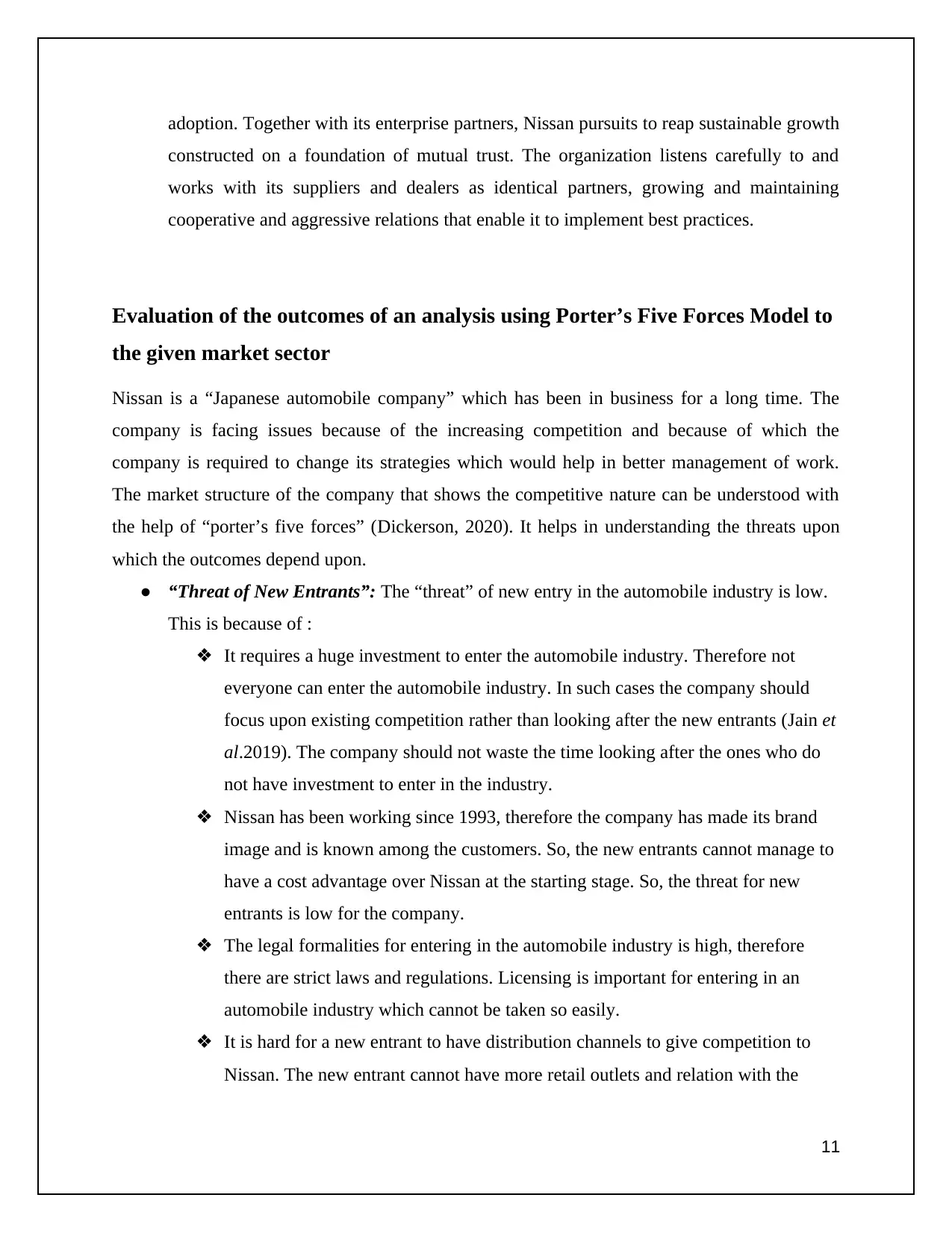
adoption. Together with its enterprise partners, Nissan pursuits to reap sustainable growth
constructed on a foundation of mutual trust. The organization listens carefully to and
works with its suppliers and dealers as identical partners, growing and maintaining
cooperative and aggressive relations that enable it to implement best practices.
Evaluation of the outcomes of an analysis using Porter’s Five Forces Model to
the given market sector
Nissan is a “Japanese automobile company” which has been in business for a long time. The
company is facing issues because of the increasing competition and because of which the
company is required to change its strategies which would help in better management of work.
The market structure of the company that shows the competitive nature can be understood with
the help of “porter’s five forces” (Dickerson, 2020). It helps in understanding the threats upon
which the outcomes depend upon.
● “Threat of New Entrants”: The “threat” of new entry in the automobile industry is low.
This is because of :
❖ It requires a huge investment to enter the automobile industry. Therefore not
everyone can enter the automobile industry. In such cases the company should
focus upon existing competition rather than looking after the new entrants (Jain et
al.2019). The company should not waste the time looking after the ones who do
not have investment to enter in the industry.
❖ Nissan has been working since 1993, therefore the company has made its brand
image and is known among the customers. So, the new entrants cannot manage to
have a cost advantage over Nissan at the starting stage. So, the threat for new
entrants is low for the company.
❖ The legal formalities for entering in the automobile industry is high, therefore
there are strict laws and regulations. Licensing is important for entering in an
automobile industry which cannot be taken so easily.
❖ It is hard for a new entrant to have distribution channels to give competition to
Nissan. The new entrant cannot have more retail outlets and relation with the
11
constructed on a foundation of mutual trust. The organization listens carefully to and
works with its suppliers and dealers as identical partners, growing and maintaining
cooperative and aggressive relations that enable it to implement best practices.
Evaluation of the outcomes of an analysis using Porter’s Five Forces Model to
the given market sector
Nissan is a “Japanese automobile company” which has been in business for a long time. The
company is facing issues because of the increasing competition and because of which the
company is required to change its strategies which would help in better management of work.
The market structure of the company that shows the competitive nature can be understood with
the help of “porter’s five forces” (Dickerson, 2020). It helps in understanding the threats upon
which the outcomes depend upon.
● “Threat of New Entrants”: The “threat” of new entry in the automobile industry is low.
This is because of :
❖ It requires a huge investment to enter the automobile industry. Therefore not
everyone can enter the automobile industry. In such cases the company should
focus upon existing competition rather than looking after the new entrants (Jain et
al.2019). The company should not waste the time looking after the ones who do
not have investment to enter in the industry.
❖ Nissan has been working since 1993, therefore the company has made its brand
image and is known among the customers. So, the new entrants cannot manage to
have a cost advantage over Nissan at the starting stage. So, the threat for new
entrants is low for the company.
❖ The legal formalities for entering in the automobile industry is high, therefore
there are strict laws and regulations. Licensing is important for entering in an
automobile industry which cannot be taken so easily.
❖ It is hard for a new entrant to have distribution channels to give competition to
Nissan. The new entrant cannot have more retail outlets and relation with the
11
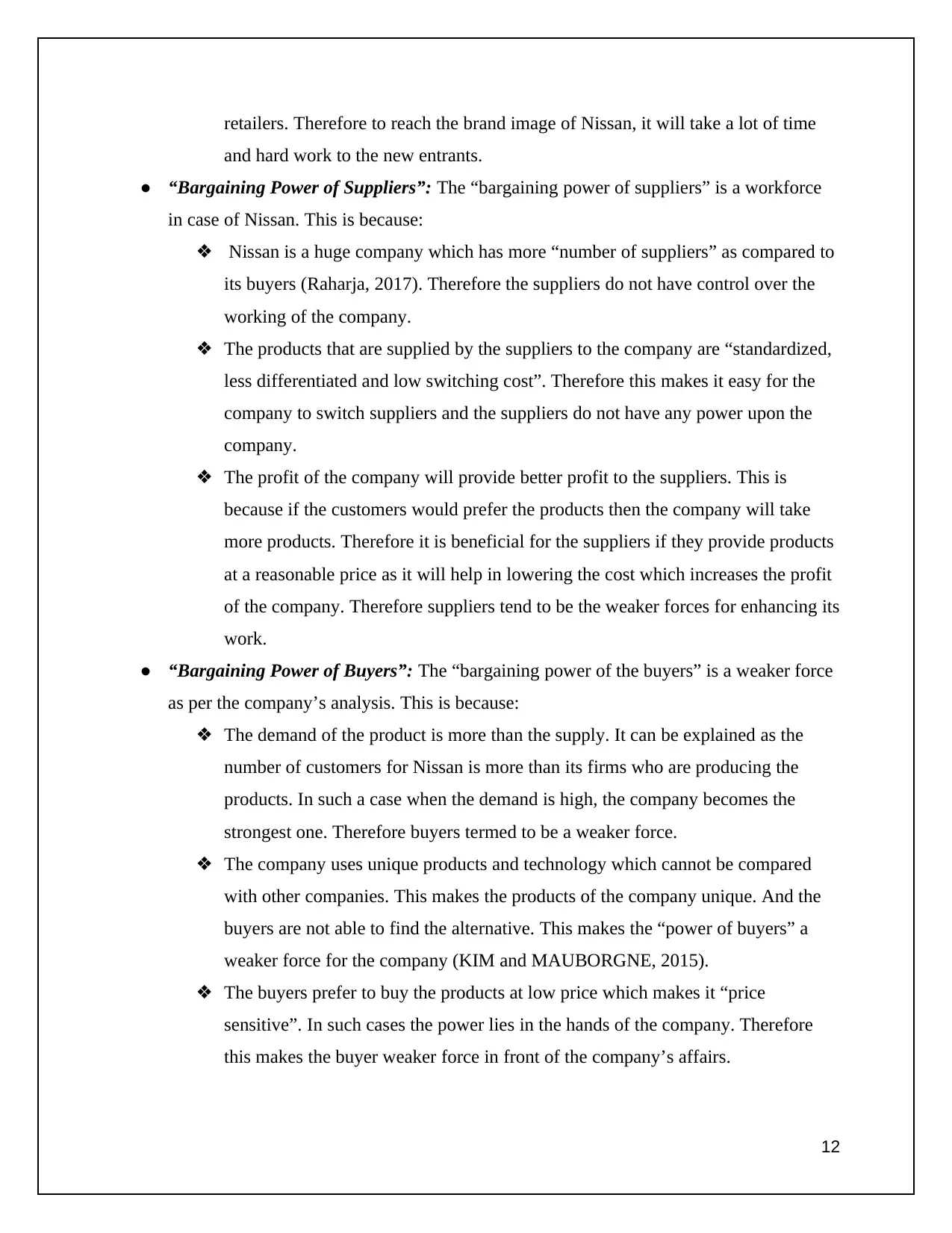
retailers. Therefore to reach the brand image of Nissan, it will take a lot of time
and hard work to the new entrants.
● “Bargaining Power of Suppliers”: The “bargaining power of suppliers” is a workforce
in case of Nissan. This is because:
❖ Nissan is a huge company which has more “number of suppliers” as compared to
its buyers (Raharja, 2017). Therefore the suppliers do not have control over the
working of the company.
❖ The products that are supplied by the suppliers to the company are “standardized,
less differentiated and low switching cost”. Therefore this makes it easy for the
company to switch suppliers and the suppliers do not have any power upon the
company.
❖ The profit of the company will provide better profit to the suppliers. This is
because if the customers would prefer the products then the company will take
more products. Therefore it is beneficial for the suppliers if they provide products
at a reasonable price as it will help in lowering the cost which increases the profit
of the company. Therefore suppliers tend to be the weaker forces for enhancing its
work.
● “Bargaining Power of Buyers”: The “bargaining power of the buyers” is a weaker force
as per the company’s analysis. This is because:
❖ The demand of the product is more than the supply. It can be explained as the
number of customers for Nissan is more than its firms who are producing the
products. In such a case when the demand is high, the company becomes the
strongest one. Therefore buyers termed to be a weaker force.
❖ The company uses unique products and technology which cannot be compared
with other companies. This makes the products of the company unique. And the
buyers are not able to find the alternative. This makes the “power of buyers” a
weaker force for the company (KIM and MAUBORGNE, 2015).
❖ The buyers prefer to buy the products at low price which makes it “price
sensitive”. In such cases the power lies in the hands of the company. Therefore
this makes the buyer weaker force in front of the company’s affairs.
12
and hard work to the new entrants.
● “Bargaining Power of Suppliers”: The “bargaining power of suppliers” is a workforce
in case of Nissan. This is because:
❖ Nissan is a huge company which has more “number of suppliers” as compared to
its buyers (Raharja, 2017). Therefore the suppliers do not have control over the
working of the company.
❖ The products that are supplied by the suppliers to the company are “standardized,
less differentiated and low switching cost”. Therefore this makes it easy for the
company to switch suppliers and the suppliers do not have any power upon the
company.
❖ The profit of the company will provide better profit to the suppliers. This is
because if the customers would prefer the products then the company will take
more products. Therefore it is beneficial for the suppliers if they provide products
at a reasonable price as it will help in lowering the cost which increases the profit
of the company. Therefore suppliers tend to be the weaker forces for enhancing its
work.
● “Bargaining Power of Buyers”: The “bargaining power of the buyers” is a weaker force
as per the company’s analysis. This is because:
❖ The demand of the product is more than the supply. It can be explained as the
number of customers for Nissan is more than its firms who are producing the
products. In such a case when the demand is high, the company becomes the
strongest one. Therefore buyers termed to be a weaker force.
❖ The company uses unique products and technology which cannot be compared
with other companies. This makes the products of the company unique. And the
buyers are not able to find the alternative. This makes the “power of buyers” a
weaker force for the company (KIM and MAUBORGNE, 2015).
❖ The buyers prefer to buy the products at low price which makes it “price
sensitive”. In such cases the power lies in the hands of the company. Therefore
this makes the buyer weaker force in front of the company’s affairs.
12
⊘ This is a preview!⊘
Do you want full access?
Subscribe today to unlock all pages.

Trusted by 1+ million students worldwide
1 out of 20
Related Documents
Your All-in-One AI-Powered Toolkit for Academic Success.
+13062052269
info@desklib.com
Available 24*7 on WhatsApp / Email
![[object Object]](/_next/static/media/star-bottom.7253800d.svg)
Unlock your academic potential
Copyright © 2020–2025 A2Z Services. All Rights Reserved. Developed and managed by ZUCOL.





